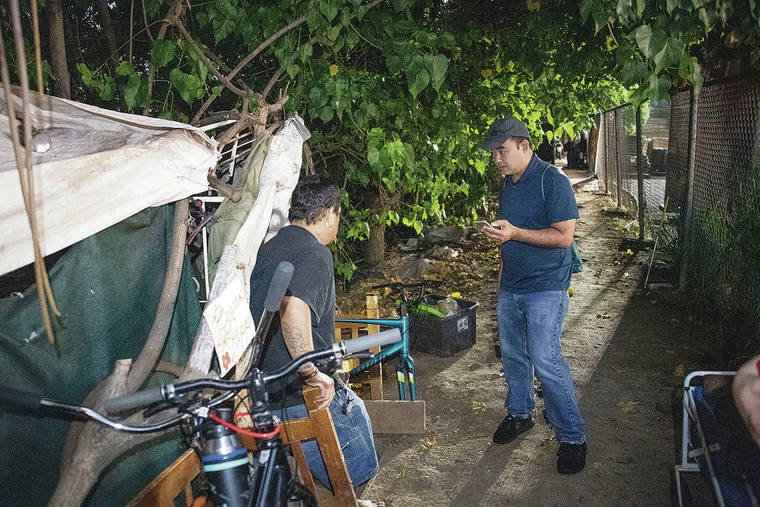Hawaii sees slight uptick in homeless population

CRAIG T. KOJIMA /CKOJIMA@STARADVERTISER.COM
State homeless coordinator Scott Morishige spoke to homeless people living next to Waimalu Stream during the Point in Time count in January. This year 1,074 of the people identified as homeless on Oahu were counted through observation rather than via interview, a technique used in some mainland cities.
Hawaii lost its ignoble distinction last year of having the highest per capita rate of homelessness in America, but Oahu’s homeless count increased by 0.7 percent during the nation’s latest annual homeless census, while the neighbor islands saw a similar 1% increase.
How each island’s homeless numbers for 2020 affect the state’s overall standing compared with the rest of the nation likely won’t be known until later in the year, when federal officials generally compare all of the states’ homeless populations, which are counted each January during the so-called nationwide Point in Time Count.
This year, social workers and volunteers counted 4,448 homeless people across Oahu.
At the same time, the neighbor islands’ overall homeless population in January increased to 2,010 — meaning the state’s official overall homeless population as of January was 6,458.
This year’s count represented widely different numbers on the neighbor islands and a change in how homeless people were counted on Oahu.
Hawaii island saw a 16% increase since 2019, compared with a 9% decline on Maui and 4% decrease on Kauai.
Don't miss out on what's happening!
Stay in touch with breaking news, as it happens, conveniently in your email inbox. It's FREE!
This year’s Oahu count was the result of a sharp departure from the way people were counted in the past and was designed to offer a more accurate count, according to Marc Alexander, executive director of the city’s Office of Housing, and Scott Morishige, the state’s homeless coordinator.
Instead of fanning out across Oahu over an entire week, volunteers and social workers only counted homeless people on a single day and asked people where they slept on the night of Jan. 22.
They also used a new app to tabulate the people they counted in real time, along with the more significant use of an “observational tool,” in which people who refused to be interviewed, had language issues, declined entry to their encampments or were sleeping were still counted as being homeless.
This year, 1,074 people were identified as homeless on Oahu through observation: 641 who refused to answer questions or had language issues; 324 who were sleeping and would not wake up to answer the survey; and 109 who would not allow entry to their encampments.
While the observational method is not being implemented on the neighbor islands, it is used in some big cities and other parts of the mainland, Alexander said.
He said he expected Oahu’s count this year to increase by dozens of people because of the observational method. Instead the numbers essentially remained flat compared to those gathered with the 2019 methodology.
Alexander said he was pleased by many of the numbers in this year’s Point in Time Count, while acknowledging that much more work needs to be done.
For instance, Alexander said, the 2,346 homeless people living “unsheltered” in January, or essentially on the street, fell 2% from the year before. They represented 53% of Oahu’s homeless population and generate many of Oahu’s homeless complaints.
Other encouraging signs on Oahu were the 7% drop in homeless families; 8% decline in homeless children; and 7% reduction in homeless veterans, Alexander said.
Compared with 2015, Oahu has seen a 48% drop in homeless families; 45% decline in homeless children and 24% reduction in homeless veterans.
“These are huge numbers,” Alexander said. “More importantly, they’re real people. We know what we’re doing. We just need to scale it.”
Morishige emphasized that the latest numbers — and Oahu’s change in how it counts homeless people — have to be looked at over several years, and not just a single year’s change from 2019.
At the same time, both the state and city are bracing for an expected wave of new homeless people resulting from mass layoffs and furloughs triggered by the new coronavirus. Opens in a new tab
But, like the 2008 housing crisis that triggered the great recession, the numbers of new homeless individuals and families will not be seen immediately, Morishige said.
“We need to expect a potential increase because of the significant impact from the loss of jobs in the community,” Morishige said. “It will happen over a gradual increase over a period of time. That’s what we need to be mindful of.”




